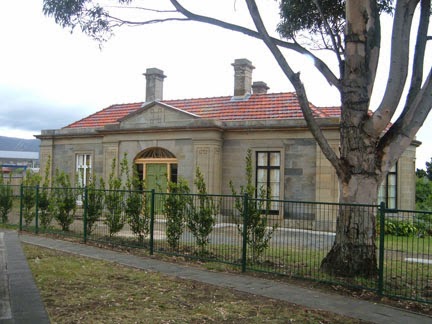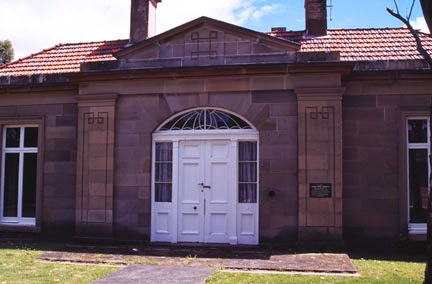By the early 1820s the property was owned by Bartholomew Broughton (c1796-1828) a convict who was a clerk to Dr Edward Bromley, the Treasurer of the Police Fund and Naval Office. When Lieutenant-Governor Arthur wrote to Earl Bathurst in October 1824 he reported that Broughton had quickly attracted his attention because his lifestyle did not appear to match his means.
A subsequent audit of the accounts quickly uncovered a spectacular misappropriation of colonial funds, the initial investigation discovering a deficiency of more than 5,000 pounds. Subsequent investigations found that Bromley had not kept any records and, while it seems almost certain that Broughton embezzled funds, the incredible laxness of Bromley's administration made it impossible to prove. However, Broughton had his conditional pardon cancelled and Bromley was dismissed from his office and all his property was seized to repay his debts.
Charles Swanston occupied the property, which he renamed New Town Park, from shortly after his arrival in Van Diemen's Land in 1829 and purchased it in August 1832. Swanston was an extremely powerful figure in the colony acting as an import and export agent for a number of firms, attracting large amounts of overseas capital for investment at high rates of interest, and becoming managing director of the Derwent Bank. In 1835 Swanston formed the Port Phillip Association which supported John Batman's expedition to establish grazing properties in today's Victoria (this is why one of the main thoroughfares in Melbourne is called Swanston Street).
New Town Park House was built in the mid 1830s by Thomas White and Henry W Seabrook, a building partnership responsible for constructing many of the principal residences in New Town. Swanston was financially ruined by the economic depression of the late 1840s and New Town Park was advertised for public auction in February 1850. 'The much-admired, splendid, commodious, and most delightfully situated family mansion … suitable for a family of the highest respectability' was purchased by William Carter (c1796-1878), the first Mayor of Hobart.
Henry Hopkins Jnr (1822-1875) purchased New Town Park on 16 acres in February 1865 for 3,300 pounds. In his will, Hopkins left New Town Park to Henry Cook (1821-1890) on the proviso that Cook would allow Hopkins' widow to live there as one of his family. In the event Hopkins' widow declined and released Cook from the obligation in an indenture dated October 1877.
James Wilkinson Whyte (1852-1923), Registrar of Land Titles, purchased New Town Park in 1893 and lived there until his death. He was followed up as owner by his son until 1939. The estate was purchased by the Tasmanian Government in March 1941. When the property was acquired it was 'complete with the earlier low wing and court yard. These have been demolished in planning the new obstetric hospital and nurses home but the Swanston mansion and granary have been retained. The latter building is said to have housed a skittle alley.
The buildings are classified by the National Trust and today sit within the Douglas Parker Rehabilitation Centre complex.
Main Text, Information & Main House Photos Source – Australian Heritage Database
Australian Dictionary of Biography - Charles Swanston
Australian Dictionary of Biography - Edward Bromley
Updated 21/7/2015
Thank you to Vicki Farmery
(Photographic Collections Manager - Tasmanian Museum & Art Gallery)
for supplying the information regarding Henry Hopkins Jnr and his ownership of New Town Park.
Updated 24/10/2015
Thank you to Dave Broughton of Iffley, Oxford
for his generous contribution of the the following information about Bartholomew Broughton
Updated 21/7/2015
Thank you to Vicki Farmery
(Photographic Collections Manager - Tasmanian Museum & Art Gallery)
for supplying the information regarding Henry Hopkins Jnr and his ownership of New Town Park.
Updated 24/10/2015
Thank you to Dave Broughton of Iffley, Oxford
for his generous contribution of the the following information about Bartholomew Broughton
"Just wanted to add a couple of things about Bartholomew Broughton which you may find of interest.
He was born in London 30th Jan 1792 and baptised in St Clements Danes Church, Westminster 26th Feb 1792 (source:Parish Register). His father was a well respected solicitor who worked and lived near Grays Inn Lane, London. Bartholomew's mother, Martha, sadly died when he was just 4 years old. His father remarried Sept 1798.
It's likely that he was a naval Lieutenant probably serving in the Napoleonic Wars or perhaps serving in India. His first few months after arriving aboard the Dromedary was served out as clerk to JT Campbell, Lachlan Macquarie's secretary. It was Macquarie who granted him his ticket of leave and passage to Hobart where he became the Naval Clerk to Bromley.
Its widely accepted that Bartholomew Broughton was Tasmania's first commercial wine producer, the grapes grown of course at Prospect Farm. He appears to have been a considerate person making a deed of settlement in favour of Malvina Hobson who cohabited with him. When he died in 1828, Swanston soon had the Surveyor-General mapping out land that had belonged to Broughton. It took Swanston some few years before finally Malvina Hobson sold her rights to the property (although this was strongly contested by Andrew Bent one of the two executors, and also Bartholomew's father back in England).
Having researched the early days of Tasmania as a colony I'm left in no doubt that life was "survival of the fittest". It remains to me one of the legacy's of Tasmania that whatever label you use be it free-settler or convict, the struggle to survive often lead to a fine line being drawn between what was right and what was wrong."
Hope you find the above of interest.
All the very best,
Dave Broughton
Iffley
Oxford








